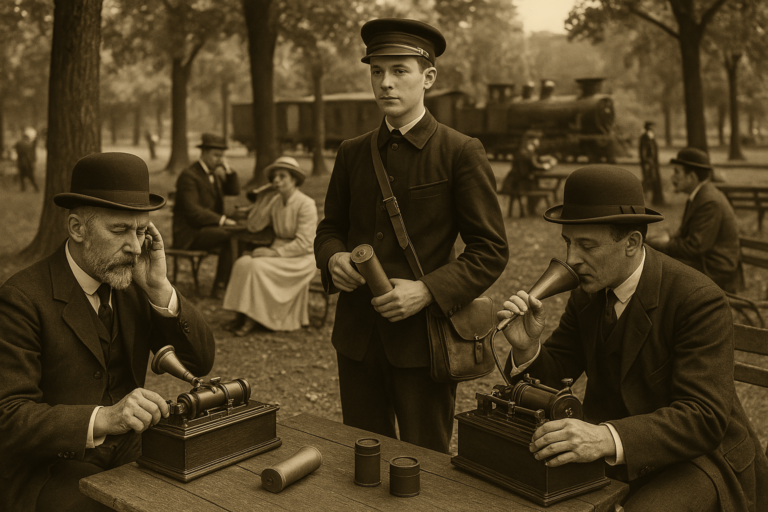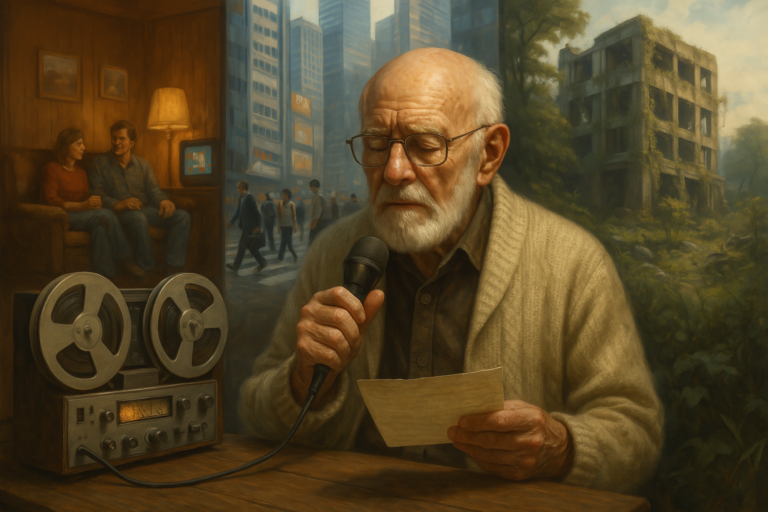
[Camera opens on a quiet, tree-lined street in small-town America. A modest brick building stands with a faded sign reading “U.S. Type—Est. 1922.”]
Voiceover (in classic 60 Minutes fashion, but with a wry tone):
“Tonight on NOT 60 Minutes, we’re investigating a curious case of government inertia—some call it pork, others call it old-fashioned waste. In a world of tablets and drones, why does a single typewriter factory still receive 10 million dollars each year in federal subsidies? It’s a question that seems to have a simple answer: bureaucracy gone wild. But as we dug deeper, we discovered that the real story here isn’t about cost overruns or musty legal forms—it’s about the people who quietly keep those typewriters clattering away.”
Part I: The “Waste”
[Cut to a shot of dusty typewriters on assembly lines, the faint clack of keys heard in the background.]
Voiceover:
“At first blush, U.S. Type is everything you’d expect from a government boondoggle. Old IRS forms still require typed entries, archaic Defense Department manuals call for non-electronic backups in case of an EMP attack, and it’d cost billions to update every last piece of documentation. So, for a mere ten million dollars a year, the federal government keeps this factory open—on paper, at least—to satisfy these fossilized regulations.”
[Camera pans to an antiquated government binder labeled ‘U.S. Type Protocols.’]
“Add to that the lonely archivist whose sole job is to keep said protocols alive—closing the factory would trigger a domino effect of legal and political nightmares. All of this we expected to find. But what we didn’t expect was a full-blown soap opera.”
Part II: The Unraveling Soap Opera
[We see an interior shot of the factory floor, workers milling about. The lighting flickers slightly, giving the place a distinctly noir vibe.]
Voiceover (with increasing curiosity):
“Meet Earl, a machinist who, according to several employees, has been sabotaging equipment to score extra overtime. But sabotage isn’t the only reason Earl likes those late nights at the factory—he has an altogether more personal motive involving Tracy, the custodian.”
[Camera cuts to Earl, looking flustered, holding a broken typewriter ribbon spool.]
Earl (slightly embarrassed, shifting his weight): “I’m just doin’ what needs to be done, ya know? Sometimes machines gotta be fixed. Sometimes you fix ’em more than once.”
Voiceover (barely hiding amusement):
“But if you ask Deborah, Earl’s wife and keeper of the factory’s scant typewriter orders, there’s more to Earl’s after-hours tinkering. She believes his sabotage covers up flirtation with Tracy—and she may be right. Except Deborah herself is no saint: rumor has it she’s been spending time with Frank, the foreman—and that their hallway chats aren’t strictly about machine parts.”
Part III: Tangled Loyalties
[The camera follows Tracy into a dimly lit hallway. She carries a stack of cleaning supplies.]
Voiceover:
“Tracy, the factory custodian, sees Earl as a mentor. But those late-night sessions with Carl, the night watchman, might say otherwise. Carl, in turn, keeps encouraging Tracy to request more ‘special repairs’—the kind that guarantee him extra hours. And that’s not even the half of it.”
[Cut to a small, dingy breakroom where Carl sits with a coffee cup, looking shifty-eyed.]
Voiceover (in a whisper):
“Carl confided that he’s saving up for an exit strategy—away from the factory, away from this town, maybe even away from Tracy. He’s been using her loyalty to get extra shifts. Meanwhile, Tracy’s twin brother, Steve, is determined to keep Carl in the factory any way he can—going so far as to fudge inventory numbers to ensure they have to order more ribbons, more parts, and keep Carl on the payroll.”
Part IV: The HR Angle
[Camera finds Rita, the HR manager, in her cramped office lined with binders.]
Voiceover:
“Rita is officially engaged to Frank, the foreman, though that might not last. She suspects him of cozying up to Deborah, but she also hears rumors from Earl that Frank’s lax supervision is responsible for the factory’s rising repair costs. All the while, Tracy’s starry-eyed praise of Frank’s leadership style only fuels Carl’s paranoia—making him cling even tighter to his sabotage-friendly side hustle.”
Rita (glancing at a folder of complaints): “I’ve got pages of these… mechanical failures, suspicious timecards. And if I blow the whistle on sabotage, I’ll tear the place apart. Not that it’s a well-oiled machine to begin with.”
Part V: The Shift in Focus
Voiceover (breathless, as if the reporter has been up all night following gossip):
“At this point, I’d love to tell you about the additional $300,000 the government has allocated for special typewriter ribbons. Or the multi-year contract paying for the archivist who basically sits alone all day. But I’ve spent so much time piecing together who’s secretly pining for whom, who’s sabotaging which machine, and who’s using whom to clock extra overtime… that the financial details have started to feel like a footnote.”
[Cut to the reporter’s face, looking genuinely fascinated, flipping through scribbled notes on factory gossip rather than official documents.]
Reporter (in a casual off-camera aside):
“I came here to do a hard-hitting piece on government waste. Instead, I’ve become an amateur couples’ counselor, conspiracy theorist, and human resources investigator—sometimes in the same conversation. Every time I try to ask about cost overruns, I end up hearing about clandestine romances or covert ink-ribbon sabotage.”
Part VI: Where We End Up
[Camera slowly moves through the factory’s main floor. Employees glance warily at each other, gears and belts whir in the background.]
Voiceover (softening in tone, more reflective):
“Is it a colossal waste of taxpayer money to prop up a factory whose primary function seems to be fueling small-town drama? Probably. But after witnessing Earl’s longing looks at Tracy, Deborah’s attempts to keep tabs on Earl while flirting with Frank, and Steve’s desperate moves to keep Carl from leaving… I find myself less concerned about the million-dollar line items. Frankly, the real story here is the tangle of human hearts and hopes that cling to every last typewriter key.”
[Shot of the reporter standing outside the factory’s front door at twilight.]
Voiceover (with a weary chuckle):
“In the end, those old forms and defense manuals remain unchanged. The archivist, the committees—still in place. Congress will likely continue shelling out money to keep U.S. Type alive. And for once, I’m not even outraged. Because there’s something almost… sweet about a place where the biggest meltdown is a broken typewriter spool that might, just might, make or break someone’s love life.”
Final Thoughts
[The camera settles on a single, well-worn typewriter in the breakroom, a half-typed letter in it. We see a faint coffee ring next to it on the table.]
Voiceover (in that signature 60 Minutes closing style, but with a hint of laughter):
“If you’re looking for wasteful spending, you’ll find it here in spades. But if you’re looking for people stumbling through relationships, secrets, and sabotage—well, you’ll find that too. Perhaps the real question is whether saving a factory is about preserving old bureaucratic rules… or a place where, despite everything, human connections flourish amid the clatter. From U.S. Type, this is NOT 60 Minutes, signing off—still not entirely sure if I’ve uncovered government waste or just gotten lost in one spectacularly tangled love triangle.”
[Fade to black with the distant sound of typewriter keys tapping, as if they’re continuing some unseen story.]


